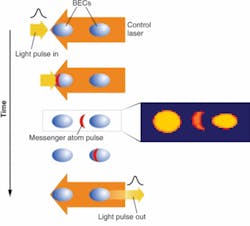LASER OPTICAL DATA PROCESSING: Bose-Einstein condensates enable light revival
Researchers at Harvard University (Cambridge, MA) have used a quantum-mechanical interference process to extinguish a light pulse in one location and then revive it in a totally separate location. Lene Hau, the Harvard professor who leads the team, described the achievement as a potential “missing link” that might eventually enable, among other things, optical data processing in both classical and quantum realms.1
The researchers essentially converted a light pulse into a matter wave within a Bose-Einstein condensate (BEC), and allowed the matter wave to propagate out of its container and into a different and remote BEC where it was converted back into a light pulse (see figure). Hau attributed the successful demonstration to a key characteristic of BECs. “Within these clouds, atoms become phase-locked, losing their individuality and independence,” she said. “The lock-step nature of atoms in a BEC makes it possible for the information in the initial light pulse to be replicated exactly within the second cloud of sodium atoms, in which the atoms collaborate to revive the light pulse.”
The two BECs, spatially separated by more than 100 µm and each containing almost 2 million sodium atoms, were created independently of each other in a double-well trapping potential (somewhat like the biological phenomena of fraternal twins, born simultaneously from the same mother but different eggs). The independence between the BECs was maintained from the time of their creation to avoid forming any connections that would enable atoms to tunnel back and forth between them, Hau said.
A pumped dye laser at the 589 nm yellow sodium line (D1) provided a continuous-wave illuminating laser beam that was met, in the first BEC, by a counterpropagating 3-µs-long Gaussian probe laser pulse with a wavelength that was almost the same but shifted slightly with an acousto-optic modulator. Quantum-mechanical destructive interference by the two laser beams was created by formation of coherent-superposition dark states within the sodium atoms in the BEC that prevented the atoms from absorbing light from either beam. The interference also effectively slowed the light pulse down to about 15 miles per hour and spatially compressed it from 1 km in free space to about 20 µm, Hau said, enabling it to fit snugly inside the condensate.
When the coupling laser was turned off, the atoms in the cloud maintained the dark state by extinguishing the light pulse. But because of the coherent state of the atoms in the BEC, no energy was lost. The sodium atoms in the cloud retained a holographic imprint with the same amplitude, phase, and shape as the pulse, and it continued to propagate as a matter wave in the same direction as the original probe pulse, out of the BEC in which it was formed and toward the second BEC. The propagation speed of the matter wave between the two BECs was about 700 ft per hour, Hau said.
After the matter wave entered the second BEC, the researchers turned the coupling beam back on. The probe pulse was reconstituted from the matter wave in its original phase and shape, and continued to propagate through the second BEC (under slow light and compressed conditions) until it left the BEC and began to accelerate and expand back to normal free-space propagation.
Manipulating data
The successful demonstration offers several potential avenues for manipulation and processing of data encoded in light fields. The team has already shown that atom dynamics can be used to vary the phase patterns and shape of the revived pulse. Numerous possibilities for processing arise—in particular, while the light pulse is traveling as a matter wave between the two BECs.
“Matter is easy to manipulate compared to light,” Hau said. “You can grab or pinch it with lasers, and can change the shape and phase.” The potential for optical processing would include classical and quantum information processing, as well as, for instance, reading classical data in and quantum data out. Hau also proposed the possibility of a new type of interferometer in which selected parts of an atomic wave function interfere.
“While the matter is traveling between the two Bose-Einstein condensates, we can trap it, potentially for minutes, and reshape it-change it-in whatever way we want,” she said.
REFERENCE
1. N.S. Ginsberg et al., Nature 445(7128) 623 (Feb. 8, 2007).
Hassaun A. Jones-Bey | Senior Editor and Freelance Writer
Hassaun A. Jones-Bey was a senior editor and then freelance writer for Laser Focus World.
